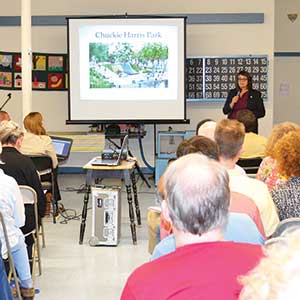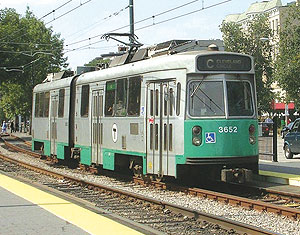
Ward 1 residents got updated reports from city officials and analysts last week. – Photo by Harry Kane
By Harry Kane
On Thursday, East Somerville residents gathered at the Cross Street Senior Center to listen to presentations from city officials regarding the current affairs most important in the community.
The City of Somerville collects and analyzes large amounts of community data. City representatives then release these statistics at community forums called ResiStat meetings. Qualitative analyses of these statistics may also be used to inform public policy. For example, some of the talking points on Thursday revolved around subjects such as finance, education, transportation, rodent control, park renovations and crime statistics.
Community Engagement Specialist Meghann Ackerman provided the residents of Ward 1 with a brief introduction to begin the meeting.
Ackerman relayed the importance of the community-generated input used to create each ResiStat meeting. “We look through the topics and pick things that people are really interested in hearing about,” she said enthusiastically.
Somerville is on the “cutting edge of so many elements of municipal management,” said Bradley Rawson, economic development planner for the City of Somerville. Rawson listed the ResiStat meetings, childhood obesity program (Shape up Somerville) and the 311-call center as just a few of the programs that give Somerville the edge and establish the city as a “national leader.”
Rawson’s overview of community planning focused on the “Somerville by Design” initiative, a city-wide program that aims at “creating safer, friendlier, and more efficient streets,” according to the City of Somerville’s website. The hope is to make the City of Somerville more accessible. “It is really a step beyond the city’s traditional role of planning, zoning, community development, transportation,” said Rawson.
Two core elements contribute to the “Somerville by Design” initiative, said Rawson. Firstly, the City of Somerville has been pro-active in finding innovative ways like community conversations in neighborhoods and increased web activity to promote community input. Secondly, the city has focused on urban design. “We try to get ahead of change,” he added.
The “Somerville by Design Street Series” recently finished in Gilman, Magoun, and Ball Squares to ready the communities for the Green Line. The program will be expanding into East Somerville to talk about the “big picture, master plan for the neighborhood,” continued Rawson.
Over the next six months there will be meetings and open studio sessions to address the design concepts for streets while respecting and preserving the historical character of the neighborhoods. On May 28, at the Michael E. Capuano Early Childhood Center, a “Somerville by Design” meeting will be held at 6:30 p.m. to discuss the next six months of work.
Hayes Morrison, the City of Somerville’s director of transportation and infrastructure, spoke to Ward 1 residents about the ongoing East Broadway streetscape project. The roughly $8 million construction project will include an overhaul of water, sewer, and drainage systems. Pedestrians will have better access due to larger, ADA accessible sidewalks. Plus, crosswalks may have chirping sounds for added safety.
The East Broadway streetscape is going to implement the “Complete Streets” design, said Morrison. “It is an implementation method to make roadways in our city safe for all users: pedestrians, cyclists, transit users and motorists,” explained Morrison.
The “Complete Street Series” is an extension of the “Somerville by Design” initiative, and took place in February, March and April to solicit community feedback. The city will compile the information into a typology book in the coming months.
The presentation then shifted to the Green Line Extension. The City of Somerville broke ground with the first phase of construction in December of 2012, according to Morrison. New inside information which Morrison couldn’t divulge much of, concerns the MBTA’s interview of the final three candidates for the construction manager general contractor position.
 Lechmere Station, Washington Street Station and the Union Square Station are all funded with state bond money that is in the final stages of approval at the State House, said Morrison. The three stations will open in 2016. The plan is to construct each station at the same time and open all three simultaneously.
Lechmere Station, Washington Street Station and the Union Square Station are all funded with state bond money that is in the final stages of approval at the State House, said Morrison. The three stations will open in 2016. The plan is to construct each station at the same time and open all three simultaneously.
Some audience members had questions concerning the construction of the Green Line. One attendee asked whether Somerville residents would be guaranteed jobs during construction. Morrison responded by saying that the interested party would have to contact the MBTA for further information. Morrison has signed a confidentiality agreement and was prohibited from speaking further about that information.
Another resident asked whether there was going to be an increased frequency in trains running to and from the new stations. “They’re not increasing the number of trains,” said Morrison. “The headway, if I remember correctly, and I will double check for you, is every 10 minutes to Union and every 8 minutes to Washington Street at rush hour; every 15 minutes at off-peak hours.”
Morrison did note that as part of the project, 24 new green-line-cars would be provided for the estimated increased transit ridership.
Another resident asked if there would be an express train. The answer was no, there isn’t enough room. “There’s a pinched lane in the right of way, right in the vicinity of about the Medford Street Bridge where you can squeeze this in, and an 8-foot bike path, that’s it,” Morrison said. “In fact, some of the engineers called it ‘building a diorama in a shoebox.”’ Laughter and applause followed this last comment.
Next, Senior Planner Luisa Oliveira spoke about the Chuckie Harris Park construction. The park is located directly behind the Cross Street Senior Center at 15-25 Cross St. “We’re starting to put in the play sections,” said Oliveira, “and we hope to be completed in about a month’s time.”
The park is made in memory of a boy named Chuckie Harris, who died in 1970. There will be a small memorial for him at the entrance of the park.
Homages to historical landmarks were incorporated into the play elements of the park, including a constructed hill with a slide. This hill is a symbolic reference to Mt. Benedict, “an oval mound of clay formed by glacial movement,” according to the East Somerville Main Streets website.
There is a toddler area with a factory building, which is a “nod to Assembly Square,” said Oliveira. As well, some new-age features include a waterfall movie screen. “When it’s summer, there’s like a mist that comes down, so you can play on it,” said Oliveira, “and then there’s a screen. You can sit on the lawn and watch movies.”
The next speaker was Maria Carpenter, director of Somerville Public Library. During the month of February, Somerville competed in a library card sign-up campaign between Arlington, Belmont and Lexington to see which community could increase more library memberships overall. “We rocked the house,” said Carpenter. Somerville was the winner with a 320 percent increase in cardholders. That translates into 1,054 residents with library cards.
“We worked very closely with our super school system,” said Carpenter, “and almost all of our school children from kindergarten through 8th grade, now have their library cards.”
The libraries are now open on Saturday mornings, said Carpenter. There is also more multilingual programming. Currently, there are plans to renovate the libraries, and $3.5 million has been earmarked in the capital plan for design work.
Following Carpenter’s enthusiastic speech about library successes, Former Superintendent of Inspectional Services Douglass Kress informed the attendees of the latest status on rodent infestation.
“Rodents, I hate to tell you, but they’re a lot like us,” said Kress. “They are going to go after the same things that we’re going to go after.” Kress listed food, shelter and water as the necessities that rodents seek. The biggest rodent problem is the rats.
The city is going to continue baiting the sewers. Standing water and food need to be properly disposed of, and due to serious problems in the past, trash regulations will be strictly enforced. The city is cracking down on the rat infestation, but Kress said that it wasn’t going to be solved unless the entire community was pro-active in deterring the rats. It’s important to call 311 if rats are sighted, said Kress, because the city tracks the hotspots where rats are spotted and then baits the sewers in those locations.
Some residents like Toni Brogna were understandably upset with the ongoing rat infestation problem. “The rats that I do see are the size of a cat,” said Brogna. “They are morphing into something else!” While Douglass Kress listened to her comments, he didn’t respond with any comforting suggestions.
Mayor Joseph A. Curtatone entered and presented next. “I always find the rat conversation riveting,” he said. But the Mayor quickly changed course and presented information regarding fiscal planning, and Assembly Square.
“We are now in the budget development phase…we will submit to the Board of Aldermen, I believe, the day is June 5,” said Curtatone.
Fiscal 2014 begins on July 1. “We must submit a balanced budget. We cannot submit a budget with deficits,” he added.
The Mayor said the City of Somerville has started to see some incremental progress in terms of how much the city is spending and how much revenue is coming in. For the first time in a while, according to the mayor, Somerville is starting to see revenues surpassing expenditures. “We’re starting to see the daylight, the light at the end of the tunnel,” he said.
Back in fiscal 2002, Somerville was in the “best of times – the high water mark in terms of money you get from the state – state aid,” said Curtatone. At that time, a little over 40 percent of the revenue came from the Commonwealth state aid. Since 2008, “We’ve had to do a hell of a lot more with a hell of a lot less,” said Curtatone.
Controlling costs, which have skyrocketed over the last decade has been critical to the Curtatone administration. In 2002, the City of Somerville paid approximately $12 million to cover municipal heath insurance. Fast-forward a decade and the price of health insurance has tripled.
Diligent efforts have been taken to provide affordable health care coverage. Somerville switched to the Group Insurance Commission (GIC) for employees, retirees and dependents. There was a savings of $9 million, allowing for an “incredible amount in fiscal flexibility to invest in more quality of life and neighborhood services,” said Curtatone.
The City of Somerville now has a 3.9 percent unemployment rate, said Curtatone. “We’re trying to construct our budget with a lens of looking at how our policies create a system that make-up our community,” added the Mayor.
“We have to know where we fit in this constellation, this universe of systems or stars…we need to know how we manipulate, invest, leverage and improve the system around public service, around public safety…recreation, transportation, property, housing to reach that overarching purpose,” said Curtatone.
Progress at Assembly Square is ongoing. There will be some 23 thousand new jobs over the next several years, said Curtatone. And, according to the ResiStat handout, “Assembly Square will make up 29 percent of Somerville’s new growth.”
The Mayor ended his presentation by answering questions about a proposed casino in Everett. Mayor Curtatone vowed to fight against Steve Wynn’s casino. Curtatone said, “Casinos don’t build neighborhoods…casinos are a plan of desperation,” and they “polarize communities.”












Reader Comments